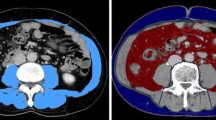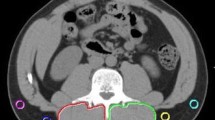Abstract
Background
Skeletal muscle depletion, referred to as sarcopenia, has been shown to be an independent predictor of lower disease-free and overall survivals in various kinds of diseases. The quality of skeletal muscle has recently attracted much attention as a new parameter of sarcopenia, but its impact on surgical complications is still unknown.
Methods
A retrospective analysis of 492 patients undergoing hepatectomy for hepatocellular carcinoma (HCC) in our institution between April 2005 and December 2014 was performed. The quality of skeletal muscle was evaluated by intramuscular adipose tissue content (IMAC) using preoperative CT imaging at the umbilical level. The impact of sarcopenia on postoperative complications and the predictors of surgical complications after hepatectomy for HCC were analyzed.
Results
Patients with high IMAC were older and had higher body mass index, higher indocyanine green retention test at 15 min, and more operative blood loss. Among 492 patients, 108 (22 %) patients had major postoperative complications (Clavien grade ≥ III), and infectious complications were found in 74 (15 %) patients. Twelve (2 %) patients died from postoperative complications. On multivariate analysis, preoperative high IMAC was an independent risk factor for increased major postoperative complications [odds ratio (OR) 1.580; P = 0.049] and infectious complications (OR 1.903; P = 0.021).
Conclusions
Preoperative muscle steatosis evaluated with IMAC was closely correlated with increased postoperative complications, especially infectious complications. The preoperative nutritional intervention and rehabilitation might lead to the improvement of postoperative outcomes after hepatectomy for HCC.

Similar content being viewed by others
References
Bray F, Ren JS, Masuyer E et al (2013) Global estimates of cancer prevalence for 27 sites in the adult population in 2008. Int J Cancer 132:1133–1145
Forner A, Llovet JM, Bruix J (2012) Hepatocellular carcinoma. Lancet 379:1245–1255
Llovet JM, Schwartz M, Mazzaferro V (2005) Resection and liver transplantation for hepatocellular carcinoma. Semin Liver Dis 25:181–200
Kusano T, Sasaki A, Kai S et al (2009) Predictors and prognostic significance of operative complications in patients with hepatocellular carcinoma who underwent hepatic resection. Eur J Surg Oncol 35:1179–1185
Yang T, Zhang J, Lu JH et al (2011) Risk factors influencing postoperative outcomes of major hepatic resection of hepatocellular carcinoma for patients with underlying liver diseases. World J Surg 35:2073–2082. doi:10.1007/s00268-011-1161-0
Cruz-Jentoft AJ, Baeyens JP, Bauer JM et al (2010) Sarcopenia: European consensus on definition and diagnosis: report of the European working group on sarcopenia in older people. Age Ageing 39:412–423
Prado CM, Lieffers JR, McCargar LJ et al (2008) Prevalence and clinical implications of sarcopenic obesity in patients with solid tumours of the respiratory and gastrointestinal tracts: a population-based study. Lancet Oncol 9:629–635
van Vledder MG, Levolger S, Ayez N et al (2012) Body composition and outcome in patients undergoing resection of colorectal liver metastases. Br J Surg 99:550–557
Kaido T, Ogawa K, Fujimoto Y et al (2013) Impact of sarcopenia on survival in patients undergoing living donor liver transplantation. Am J Transpl 13:1549–1556
Reisinger KW, van Vugt JL, Tegels JJ et al (2015) Functional compromise reflected by sarcopenia, frailty, and nutritional depletion predicts adverse postoperative outcome after colorectal cancer surgery. Ann Surg 261:345–352
Meza-Junco J, Montano-Loza AJ, Baracos VE et al (2013) Sarcopenia as a prognostic index of nutritional status in concurrent cirrhosis and hepatocellular carcinoma. J Clin Gastroenterol 47:861–870
Voron T, Tselikas L, Pietrasz D et al (2015) Sarcopenia impacts on short- and long-term results of hepatectomy for hepatocellular carcinoma. Ann Surg 261:1173–1183
Joglekar S, Asghar A, Mott SL et al (2014) Sarcopenia is an independent predictor of complications following pancreatectomy for adenocarcinoma. J Surg Oncol 111:771–775
Kuroki LM, Mangano M, Allsworth JE et al (2015) Pre-operative assessment of muscle mass to predict surgical complications and prognosis in patients with endometrial cancer. Ann Surg Oncol 22:972–979
Valero V 3rd, Amini N, Spolverato G et al (2015) Sarcopenia adversely impacts postoperative complications following resection or transplantation in patients with primary liver tumors. J Gastrointest Surg 19:272–281
Marcus RL, Addison O, Kidde JP et al (2010) Skeletal muscle fat infiltration: impact of age, inactivity, and exercise. J Nutr Health Aging 14:362–366
Hamaguchi Y, Kaido T, Okumura S et al (2014) Impact of quality as well as quantity of skeletal muscle on outcomes after liver transplantation. Liver Transpl 20:1413–1419
Hamaguchi Y, Kaido T, Okumura S et al (2015) Preoperative intramuscular adipose tissue content is a novel prognostic predictor after hepatectomy for hepatocellular carcinoma. J Hepatobiliary Pancreat Sci 22:475–485
Dindo D, Demartines N, Clavien PA (2004) Classification of surgical complications: a new proposal with evaluation in a cohort of 6336 patients and results of a survey. Ann Surg 240:205–213
Maithel SK, Kneuertz PJ, Kooby DA et al (2011) Importance of low preoperative platelet count in selecting patients for resection of hepatocellular carcinoma: a multi-institutional analysis. J Am Coll Surg 212:638–648
Law WL, Choi HK, Lee YM et al (2007) The impact of postoperative complications on long-term outcomes following curative resection for colorectal cancer. Ann Surg Oncol 14:2559–2566
Howard TJ, Krug JE, Yu J et al (2006) A margin-negative R0 resection accomplished with minimal postoperative complications is the surgeon’s contribution to long-term survival in pancreatic cancer. J Gastrointest Surg 10:1338–1345
Ito H, Are C, Gonen M et al (2008) Effect of postoperative morbidity on long-term survival after hepatic resection for metastatic colorectal cancer. Ann Surg 247:994–1002
Farid SG, Aldouri A, Morris-Stiff G et al (2010) Correlation between postoperative infective complications and long-term outcomes after hepatic resection for colorectal liver metastasis. Ann Surg 251:91–100
Marvos MN, de Jong M, Dogeas E et al (2013) Impact of complications on long-term survival after resection of colorectal liver metastasis. Br J Surg 100:711–718
Khuri SF, Henderson WG, DePalma RG, Mosca C, Healey NA, Kumbhani DJ, Participants in the VA National Surgical Quality Improvement Program (2005) Determinants of long-term survival after major surgery and the adverse effect of postoperative complications. Ann Surg 242:326–341 discussion 341–343
Tilg H, Moschen AR (2006) Adipocytokines: mediators linking adipose tissue, inflammation and immunity. Nat Rev Immunol 6:772–783
Park J, Morley TS, Kim M et al (2014) Obesity and cancer—mechanisms underlying tumour progression and recurrence. Nat Rev Endocrinol 10:455–465
Lutz CT, Quinn LS (2012) Sarcopenia, obesity, and natural killer cell immune senescence in aging: altered cytokine levels as a common mechanism. Aging (Albany NY) 4:535–546
Drummond MJ, Dreyer HC, Fry CS et al (2009) Nutritional and contractile regulation of human skeletal muscle protein synthesis and mTORC1 signaling. J Appl Physiol 106:1374–1384
Financial support
No financial support was received from any source for this study.
Author information
Authors and Affiliations
Corresponding author
Ethics declarations
Conflict of interest
All authors of this manuscript have no conflicts of interest.
Rights and permissions
About this article
Cite this article
Hamaguchi, Y., Kaido, T., Okumura, S. et al. Muscle Steatosis is an Independent Predictor of Postoperative Complications in Patients with Hepatocellular Carcinoma. World J Surg 40, 1959–1968 (2016). https://doi.org/10.1007/s00268-016-3504-3
Published:
Issue Date:
DOI: https://doi.org/10.1007/s00268-016-3504-3




